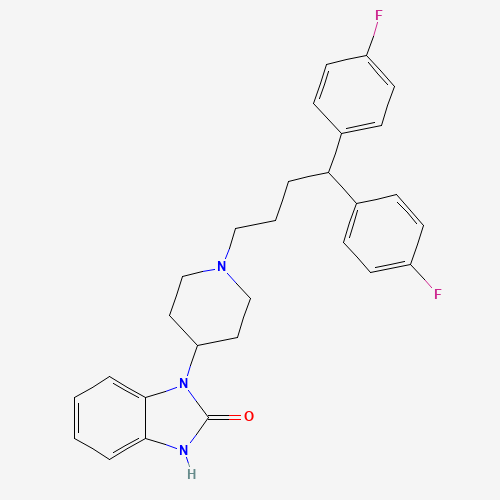| Pharmaceutical Information |
| Drug Name |
Pimozide |
| Drug ID |
BADD_D01774 |
| Description |
A diphenylbutylpiperidine that is effective as an antipsychotic agent and as an alternative to haloperidol for the suppression of vocal and motor tics in patients with Tourette syndrome. Although the precise mechanism of action is unknown, blockade of postsynaptic dopamine receptors has been postulated. (From AMA Drug Evaluations Annual, 1994, p403) |
| Indications and Usage |
Used for the suppression of motor and phonic tics in patients with Tourette's Disorder who have failed to respond satisfactorily to standard treatment. |
| Marketing Status |
approved |
| ATC Code |
N05AG02 |
| DrugBank ID |
DB01100
|
| KEGG ID |
D00560
|
| MeSH ID |
D010868
|
| PubChem ID |
16362
|
| TTD Drug ID |
D00KHM
|
| NDC Product Code |
66577-017; 76438-002; 49884-348; 49884-347; 14474-029 |
| UNII |
1HIZ4DL86F
|
| Synonyms |
Pimozide | Antalon | Orap | Orap forte | R-6238 | R6238 |
|
| Chemical Information |
| Molecular Formula |
C28H29F2N3O |
| CAS Registry Number |
2062-78-4 |
| SMILES |
C1CN(CCC1N2C3=CC=CC=C3NC2=O)CCCC(C4=CC=C(C=C4)F)C5=CC=C(C=C5)F |
| Chemical Structure |

|
|
| ADRs Induced by Drug |
|
|
*The priority for ADR severity classification is based on FAERS assessment, followed by the most severe level in CTCAE rating. If neither is available, it will be displayed as 'Not available'.
**The 'Not Available' level is hidden by default and can be restored by clicking on the legend twice..
|
|
|

